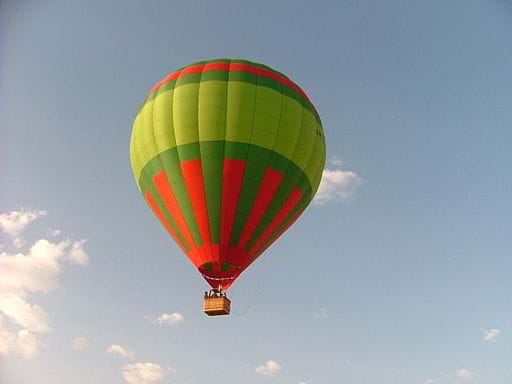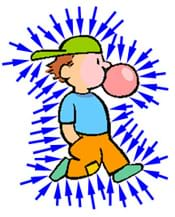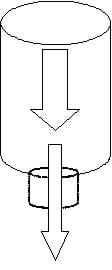Quick Look
Grade Level: 8 (7-9)
Time Required: 45 minutes
Lesson Dependency: None
Subject Areas: Physical Science

Summary
Students are introduced to the concept of air pressure and use the associated activity to see how it is affected by different variables. They explore how air pressure creates force on an object. They study the relationship between air pressure and the velocity of moving air.Engineering Connection
In designing airplanes, trains, cars, rockets and bicycles — nearly everything that moves through the air — engineers must understand Bernoulli's principle. The forces caused by moving air enable an airplane to fly or a train to slow. Understanding how Bernoulli's principle works enables engineers to take advantage of the nature of air pressure so their designs of these and many other applications function correctly, efficiently and safely.
Learning Objectives
After this lesson, students should be able to:
- Describe basic facts about the history of flight.
- Explain Bernoulli's principle.
- Describe the concept of air pressure and how the movement of air influences its pressure.
- Explain why engineers need to know about air pressure.
Educational Standards
Each TeachEngineering lesson or activity is correlated to one or more K-12 science,
technology, engineering or math (STEM) educational standards.
All 100,000+ K-12 STEM standards covered in TeachEngineering are collected, maintained and packaged by the Achievement Standards Network (ASN),
a project of D2L (www.achievementstandards.org).
In the ASN, standards are hierarchically structured: first by source; e.g., by state; within source by type; e.g., science or mathematics;
within type by subtype, then by grade, etc.
Each TeachEngineering lesson or activity is correlated to one or more K-12 science, technology, engineering or math (STEM) educational standards.
All 100,000+ K-12 STEM standards covered in TeachEngineering are collected, maintained and packaged by the Achievement Standards Network (ASN), a project of D2L (www.achievementstandards.org).
In the ASN, standards are hierarchically structured: first by source; e.g., by state; within source by type; e.g., science or mathematics; within type by subtype, then by grade, etc.
International Technology and Engineering Educators Association - Technology
-
Engage in a research and development process to simulate how inventions and innovations have evolved through systematic tests and refinements.
(Grades
6 -
8)
More Details
Do you agree with this alignment?
State Standards
Colorado - Science
-
Use mathematical expressions to describe the movement of an object
(Grade
8)
More Details
Do you agree with this alignment?
Introduction/Motivation
What is air? (Listen to student answers.) Air is a collection of molecules—very small particles that we cannot see—that cover the surface of the Earth. Air is comprised of 78% nitrogen, 21% oxygen, and the remaining 1% is mostly argon and carbon dioxide.
Blow onto your hand. What is happening? (Listen to student answers.) You are forcing air out of your lungs and it is hitting your hands.
Why doesn't air around the planet escape to space? (Listen to student answers.) Gravity pulls on air just like it pulls on a person and all objects. The weight of air is called air pressure and it pushes on us all the time. The existence of air pressure is what enables airplanes to fly.
Lesson Background and Concepts for Teachers
A Quick History of Human Flight
From the earliest times, people have marveled at the flight of birds and have wanted to fly as they do. According to Greek myth, Icarus flew too close to the sun on wings made of wax and he fell to his death. Many thousands of years later, it took a series of engineers to make this human dream of flight become a reality.
In his lifetime, Leonardo da Vinci (1452-1519), like other inventors of his time, had a fascination with the flapping flight of birds. He believed that "a bird is an instrument working according to a mathematical law. It lies within the power of humans to make this instrument with all of its motions." He designed several ornithopters, which are airplanes with flapping wings. He also designed a glider that resembles modern day hang-gliders.
In 1738, an Italian physicist named Daniel Bernoulli discovered that water and air move faster over curved surfaces than they do over flat ones. He also discovered that as the air or water moved faster, the pressure exerted by the fluid decreased. This critical discovery, known as Bernoulli's principle, paved the way for modern airplanes.
In 1903, a pair of bike shop owners from Ohio made the world's first powered flight at Kitty Hawk in North Carolina. Orville and Wilbur Wright had studied prior attempts to fly and realized that birds keep their balance by twisting their wings. In 1895, Wilbur designed a kite that reproduced this effect mechanically. Then, for several years after his kite invention, the two brothers experimented with flight using gliders. Wilbur also discovered the principle of combining rudder control with roll for smoother turns.
What Is Air Pressure?
Our atmosphere could be described as a sea of air that is about 80 kilometers thick surrounding the planet. All of that air piled on top of us is pulled down by gravity (see Figure 1). In fact, the air pushes against us in all directions. This is air pressure. Refer to the Air Pressure activity to have students learn more about the concept

How Does Air Pressure Work?
Air is pushing on all people and objects with a force of 14.7 pounds per square inch at sea level. (Disclaimer: Using the metric system, pressure is measured in newtons per square meter, which is called a pascal. With younger kids, it is easy to use pounds per square inch since the units are more familiar and the numbers are more reasonable. To convert pounds per square inch into pascals, multiply by 6,895.) As you go higher in elevation, less air is pushing down, so the air pressure is less. The change is not that great until you get very high. Heating the air, cooling it, or causing it to move can change the air's pressure. These differences in air pressure create wind, and make flight possible.
What Is Bernoulli's Principle?
Bernoulli discovered that the faster water moves over a surface, the lower the pressure the water exerts on that surface. In Figure 2, water flowing out of a bottle moves faster through the narrow neck than it does in the rest of the bottle. Students can practice this principle with the fun associated activity, Fun with Bernoulli. Bernoulli proved that the water pressure on the sides of the neck of the bottle were less than those on the sides of the rest of the bottle.

Bernoulli then found that these same principles apply to air as well. Bernoulli's principle simply states that the faster a fluid moves over a surface, the less it pushes on the surface (see Figure 3).

Engineers and the Bernoulli Princple
Engineers must fully understanding the concept represented by Bernoulli's principle when designing and testing airplane wings. They use this information to determine the amount of lift a wing will produce (how high an airplane can go). Engineers also use their knowledge of these principles for other projects relating to fluid flow. We will learn more about how Bernoulli's principle is related to flight in Lesson 2 of the Airplanes unit.
Associated Activities
- Fun with Bernoulli - This activity focuses on air pressure and Bernoulli's Principle. Students learn how air movement changes air pressure.
- Air Pressure - Students learn that air pressure is the weight of air and that air pressure changes with altitude.
Lesson Closure
Ask students to explain air pressure. Then have them explain why one of the Bernoulli's principle activities they did worked in terms of air pressure. Make sure they understand Bernoulli's principle (as fluid velocity increases the pressure decreases).
Bonus question: What is a vacuum? (Answer: A vacuum is a volume with no air in it and therefore no air pressure.)
Vocabulary/Definitions
air pressure: The force exerted by air on an area. Units: metric is newtons per square meter; English is pounds per square inch.
Bernoulli's principle: A natural physical law that pressure exerted by a fluid decreases as the rate of flow increases.
fluid: Any substance in which the molecules can move around freely. A fluid is any gas or liquid, such as air and water.
force: A push or pull on an object.
lift: The force resulting from the difference in air pressure above and below the wings that causes aircraft to move upwards.
Assessment
Pre-Lesson Assessment
Discussion Questions: Solicit, integrate, and summarize student responses.
- What is air? (Answer: Air is a collection of molecules—very small particles that we cannot see—that cover the surface of the Earth. Air is comprised of 78% nitrogen, 21% oxygen, and the remaining 1% is mostly argon and carbon dioxide.)
- Why doesn't air escape into space? (Answer: Gravity)
- Why don't you feel the air pressure? (Answer: Your body pushes out against the air to balance the air pressure.)
Post-Introduction Assessment
Voting: Ask a true/false question and have students vote by holding thumbs up for true and thumbs down for false. Tally the votes and write the totals on the board. Give the right answer.
- True or False: Air pressure is caused by the rotation of the Earth. (Answer: False. Air pressure is caused by gravity pulling air towards the Earth.)
- True or False: The faster air moves, the higher the pressure. (Answer: False. Pressure decreases as air velocity increases.)
- True of False: Air pressure pushes in all directions. (Answer: True. Air pressure not only pushes down on us, but it also pushes from the sides and even from below.)
Lesson Summary Assessment
Bingo: Provide each student with a sheet of paper containing a list of the lesson vocabulary terms. Have each student walk around the room and find a student who can define one vocabulary term. Students must find a different student for each word. When a student has all terms completed s/he shouts "Bingo!" Continue until two or three students have bingo. Ask the students who shouted "Bingo!" to give definitions of the terms.
Lesson Extension Activities
Have students conduct library or Internet research to learn more about the Bernoulli principle and how it figures into everyday products and inventions.
Subscribe
Get the inside scoop on all things TeachEngineering such as new site features, curriculum updates, video releases, and more by signing up for our newsletter!More Curriculum Like This

Students revisit Bernoulli's principle (presented in lesson 1 of the Airplanes unit) and learn how engineers use this principle to design airplane wings. Airplane wings create lift by changing the pressure of the air around them. This is the first of four lessons exploring the four key forces in fli...

Students learn about the drag force on airplanes and are introduced to the concept of conservation of energy and how it relates to drag. They learn the difference between friction drag, form drag and induced drag, and how thrust is involved. They explore the relationship between drag and the shape, ...

Students learn about the relationships between the components of the Bernoulli equation through real-life engineering examples and practice problems.
References
Hixson, B. K. Bernoulli's Book. Salt Lake City, UT: Wild Goose Company, 1991.
Physics Zone: Lessons on Forces. Science Joy Wagon. Accessed 2009. http://www.sciencejoywagon.com/physicszone/02forces/
Copyright
© 2004 by Regents of the University of ColoradoContributors
Tom Rutkowski; Alex Conner; Geoffrey Hill; Malinda Schaefer Zarske; Janet YowellSupporting Program
Integrated Teaching and Learning Program, College of Engineering, University of Colorado BoulderAcknowledgements
The contents of this digital library curriculum were developed under grants from the Fund for the Improvement of Postsecondary Education (FIPSE), U.S. Department of Education and National Science Foundation (GK-12 grant no. 0338326). However, these contents do not necessarily represent the policies of the Department of Education or National Science Foundation, and you should not assume endorsement by the federal government.
Last modified: May 28, 2019








User Comments & Tips